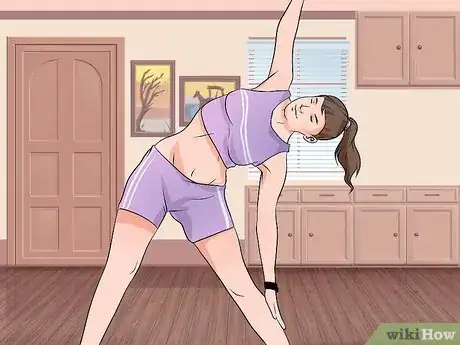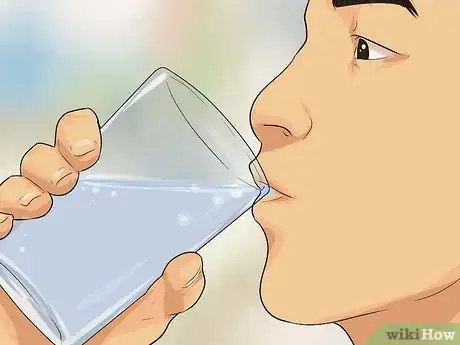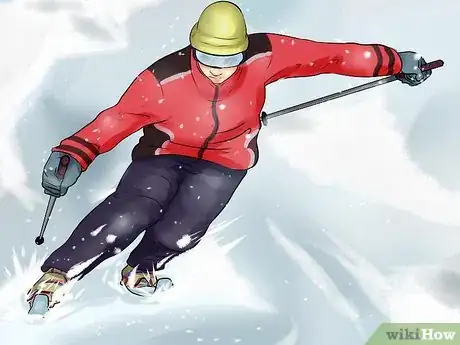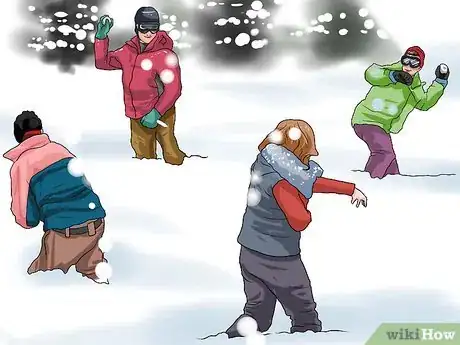This article was co-authored by wikiHow Staff. Our trained team of editors and researchers validate articles for accuracy and comprehensiveness. wikiHow's Content Management Team carefully monitors the work from our editorial staff to ensure that each article is backed by trusted research and meets our high quality standards.
There are 14 references cited in this article, which can be found at the bottom of the page.
wikiHow marks an article as reader-approved once it receives enough positive feedback. In this case, 90% of readers who voted found the article helpful, earning it our reader-approved status.
This article has been viewed 300,079 times.
Learn more...
Nobody likes being cold, but there are times when you just don’t have a choice. Cold weather can cause physical discomfort, bring about illness and make you feel lethargic if you’re not equipped to cope with it. Whether you’re moving to a place with a cooler climate or just trying to stay comfortable through the winter, there are steps you can take to become better adapted to cold temperatures.
Steps
Acclimatizing Your Body
-
1Get out in the cold. If you want to be able to get used to the cold, you’ll have to actually get out in it. If it’s late fall or winter, or if you live in an area with a year-round cold climate, spend a couple hours outside every day. Only wear as much warm clothing as necessary, and shed layers once you get more comfortable. With time, you’ll be able to spend longer and longer outside and be affected less by the temperature.[1]
- When spending long durations outside, try wearing gloves, boots and a hat, but leaving the jackets inside. It’s usually the extremities that get cold quickest, and number fingers or ears might make you call it quits long before the rest of your body actually gets too cold.[2]
- Try driving around without the heat on in your car when you have to get out. For more of a challenge, roll the windows down.
-
2Take cold showers. Turn the shower faucet opposite the direction that you’re used to when taking your daily shower. Taking cold showers can be supremely uncomfortable, but it’s a good head-first way to begin building up the body’s tolerance to immersion in cold temperatures, and it’s the closest many of us are likely to get to the practices like Arctic Sea diving that help bodies begin to make physiological adaptations to cold.
- Build up to cold showers by decreasing the temperatures that you’re used to bathing in a little at a time. If you try to go too cold too soon, you may not be able to withstand an entire shower.
- You might also try alternating between hot and cold water when showering to get used to rapid changes in temperature similar to when you step outside.[3]
Advertisement -
3Gain weight. The function of the body’s fat stores is to provide a steady supply of calories to burn for energy, and to act as cushioning layer to protect and keep the body’s internal organs at a consistent temperature. While not necessarily an attractive option, gaining body fat will keep you that much warmer when conditions are frigid.[4]
- Putting on a little extra body fat should be done with discretion; you should still aim to eat a balanced, healthy diet, just with a moderate increase in the amount of calories you ordinarily consume.
- Eating foods rich in protein, carbohydrates and healthy fats, such as lean meats, dairy, starchy whole grains and vegetable oils is a time-tested way to put on weight without placing undue stress on the heart and digestive system.[5]
-
4Exercise regularly. Start performing cardiovascular and resistance training sessions multiple times per week. Your body’s metabolism, which is responsible for breaking down calories to release energy, helps regulate your average body temperature, and becomes more efficient when adapting to the effects of intense exercise. In other words, working out will cause you run a bit hotter, as your metabolism will be kept in a healthy, revved up state.[6]
- Increasing muscle mass will help you stay warm on its own, as it’s simply more warm tissue packed on the body.[7]
- With cardiovascular exercise, your heart and lungs’ ability to circulate oxygen-rich blood will improve, making the whole machine run better.
Adjusting Your Habits
-
1Turn down the thermostat. Just as you’ve been getting used to the cold outside, you should be making an effort to get acclimated to the cold inside as well. People most often keep the temperature in their homes in the low- to mid-seventies, as this is most hospitable to the body’s equilibrium. Try turning yours down a few degrees at a time until you can stand living in a cooler space.[8]
- Toughing out a cold house is also a great way to save on the cost of utilities during the winter. Just check with your family or roommates first if you don’t live alone.
-
2Get out of the habit of covering up. The next time you get chilly and you’re tempted to grab a cozy throw blanket or pair of house shoes, don’t. Instead, bear it, and do something to take your mind off the chill if you need to. The idea is to break yourself of the need to always be covered up with warm layers when it’s cold and instead learn to cope with it on your own. If you’ve gotten used to living in cooler temperatures and have been taking cold showers routinely, this step should be a breeze.
- If you find yourself having a hard time resisting that comforter or quilt, fold it and put it away on the top shelf of a closet. You’ll be less likely to reach for it if it’s put away and you have to go to the trouble of getting it out again.
- Your body temperature naturally drops slightly when you sleep, so if you want a crash course in developing willpower, train yourself to sleep without a blanket![9]
-
3Drink ice water. Make ice water your go-to drink of choice, even in the dead of winter. Ingesting an icy beverage lowers your internal temperature ever-so-slightly, which will force your body’s adaptive responses to compensate for the change. Whereas most people turn to coffee or hot chocolate in the colder months to get warm, you should be doing the opposite. Eventually, you’ll no longer even feel the need to warm up.
- In addition to being a useful tool for building up your cold tolerance, ice water is also usually free and can be found almost anywhere.
-
4Enjoy cold-weather activities. Desensitizing yourself to the cold doesn’t have to be all stern-faced discipline. Take up an outdoor winter sport like sledding, skiing or snowboarding and give yourself a fun way to get outside while everyone else is huddled up indoors. You’ll become one with the cold much faster, and you’ll also have an enjoyable way to pass the cold months instead remaining cooped up.[10]
- Take a camping trip in the late fall or winter for a head-first approach to dealing with cold. Once you’re in the wild, you’ll have no choice but to sleep on the cold ground out in the elements, and your body will thank you!
- Chances are, you’ll begin to get overheated after a few hours of intense skiing or snowboard, demonstrating just how much heat your body is capable of generating on its own. This should give you a confidence boost for your own ability to overcome the cold.[11]
Training Your Mind
-
1Feel the actual temperature. Rather than just thinking about how cold you feel when you step outside, concentrate on feeling the exact temperature of your environment. There’s usually a stark difference: you’re hardly ever as cold as you think you are. Try to accurately gauge the cold around you so that you’re not exaggerating your response to it.[12]
- Learning to feel how cold you actually are is part of taking control over your unconscious responses to stress.
-
2Imagine that it’s even colder. It may be a little brisk out for your liking, but what if it was even colder? This is a mental trick to keep things in perspective that will serve to make cold conditions not seem so bad by comparison. If you remind yourself that there are people living in much colder places like Antarctica or Siberia without complaining, a Midwestern winter evening won’t seem quite so harsh anymore.[13]
-
3Stop shivering. Whenever you find yourself shivering, force yourself to stop. Shivering is one of the body’s heat-generating mechanisms when it’s cold, but conditions generally have to be pretty extreme for there to be an actual need for the physiological response. If the temperature outside is right around or just below freezing and you find yourself shivering uncontrollably, you’re probably overreacting.
- Shivering is an autonomic process in the body that produces heat by forcing the muscles to make tiny, rapid contractions, similar to the effects of exercise.[14]
- Research has demonstrated that shivering in non-freezing conditions is mostly unnecessary and doesn’t have a much effect on combating mild cold.[15]
-
4Know that cold is usually not a threat. It’s instinctual to react with discomfort to unusual conditions, but discomfort and danger are two different things. There’s usually no harm in being in a cold environment, as long as the cold is not severe enough to actually lower to body’s core temperature and exposure is not overly prolonged.
- Cold exposure doesn’t become life-threatening until it drops the core body temperature to around 95 degrees Fahrenheit, before which time you’d be better off swallowing your pride and finding a place of refuge with heat.[16]
Warnings
- Prolonged exposure to low temperatures can tax your body's resources, weakening your immune system and making you more susceptible to illness. Keep this in mind when training your body to get used to the cold.⧼thumbs_response⧽
- There's cold, and then there's truly cold. Don't be proud. If the temperatures outside drop to dangerous levels, or if you've already spent too long in the cold, bundle up or go inside. Beware of the factors that lead to hypothermia and its symptoms. There's no sense in taking risks with your personal health and safety.⧼thumbs_response⧽
- Frostbite is a condition in which the body's extremities undergo nerve and tissue damage as a result of prolonged exposure to cold. Always keep hands, feet and the sensitive organs of the head covered when you need to be in severe conditions for long periods of time.⧼thumbs_response⧽
References
- ↑ http://www.coolantarctica.com/Antarctica%20fact%20file/science/cold_acclimation_human.php
- ↑ http://greatist.com/live/cold-fingers-and-toes
- ↑ http://outdoors.stackexchange.com/questions/88/how-can-i-acclimatize-to-cold
- ↑ http://www.uccs.edu/Documents/healthcircle/pnc/health-topics/Weight%20Gain.pdf
- ↑ http://www.coolantarctica.com/Antarctica%20fact%20file/science/cold_acclimation_human.php
- ↑ http://www.active.com/nutrition/articles/winter-and-nutrition-fueling-for-cold-weather-exercise
- ↑ https://www.newscientist.com/article/dn22250-muscles-that-do-nothing-can-keep-you-warm-and-thin/
- ↑ http://www.active.com/swimming/articles/acclimating-your-body-to-cold-water-882380?page=2
- ↑ http://www.sleepdex.org/thermoregulation.htm
- ↑ http://kidshealth.org/en/parents/wintersports.html
- ↑ https://www.sharecare.com/health/types-exercise/body-heat-go-up-exercise
- ↑ http://www.active.com/swimming/articles/acclimating-your-body-to-cold-water-882380?page=2
- ↑ https://adamsoceans7.wordpress.com/2014/11/19/how-to-mentally-cope-with-the-cold-in-open-water-swimming/
- ↑ http://www.livescience.com/32475-why-do-we-shiver-when-cold.html
- ↑ http://io9.gizmodo.com/how-do-our-bodies-adjust-to-extreme-temperatures-1503474690
- ↑ http://www.mayoclinic.org/diseases-conditions/hypothermia/basics/definition/con-20020453
About This Article
Being cold isn’t fun, but with a few changes to your routine, you can get used to cold temperatures. To acclimate your body, try getting outside in the cold more. Once you're outside for a while, you might realize it's not as direly cold as your body thinks it is! Exercising regularly can also improve your circulation and make you less cold. When you’re inside, resist the temptation to cover up in layers. Instead, try to cope with being a little chilly for a while so your body gets used to colder temperatures. You can also start taking cold showers which will build up your tolerance to the cold. To learn how to gain weight for the winter months to keep yourself warm, read on!









































































Medical Disclaimer
The content of this article is not intended to be a substitute for professional medical advice, examination, diagnosis, or treatment. You should always contact your doctor or other qualified healthcare professional before starting, changing, or stopping any kind of health treatment.
Read More...